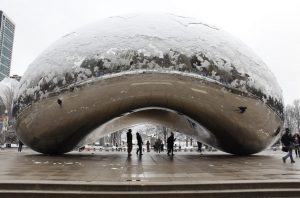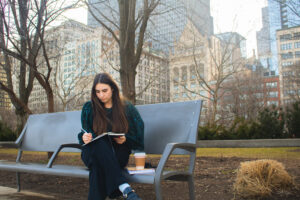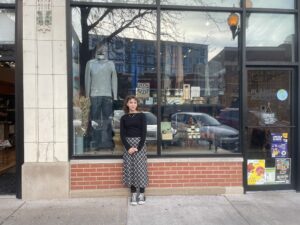As temperatures begin to rise, Chicago Craigslist ads for free couches perched up on the sidewalk begin to pop up all over the city. If no one picks up those couches, they most likely will be drenched by the rain and whisked away to the landfill along with all the other casualties of annual spring cleaning.
Americans, under the influence of shows like “Tidying Up With Marie Kondo”, have become obsessed with minimalist-style spring cleaning. People purge their excess belongings in an attempt to declutter their lives. Kondo’s method of organizing, known as KonMari, instructs viewers to only keep what “sparks joy.” Everything else must find its way out the door.
This extra spring cleaning waste could be making a negative impact on the environment. In Illinois, all that extra trash would be sent to state landfills, which in 2017 were reported to only have an average life expectancy of 20.5 years. Keeping just what “sparks joy” and purging everything else may declutter a home, but it could put a strain on Illinois’ waste management problem if little thought is given to where that extra waste will go.
“It is good for mental health, right, and personal space,” said Anne-Marie Hanson, an assistant professor of environmental studies at the University of Illinois Springfield. “But people have argued right that it does create more waste.”
She said spring cleaning waste can put a big strain in the short term on landfills.
Hanson said that with landfill capacity dwindling, the state may soon have to find alternate ways to manage the trash load — such as through incineration — unless communities can find ways to reduce their waste production.
“The epidemic of just dumping things at Goodwill or dumping things in the trash is not helpful,” said Amber Kostelny, a certified professional organizer and owner of Amber’s Organizing. Her business has been helping people in Chicago unpack, purge excess belongings and organize their homes for fifteen years.
Kostelny said that decluttering a space can help someone who is going through a life transition or may free up more of their time to spend with friends and family. “The more stuff we have, the more time it takes to manage all of it,” she said.
She encourages her clients to think twice about buying something — even if it does spark joy. “The answer is not just fill up our closet with things we love,” she said. “The answer is being a mindful shopper.”
Kostelny always advises her clients never to make The Container Store the first step in organizing. She said that she wants clients to think about where an item will end up once they no longer want it.
“When we shop, people don’t process how this is going to affect the environment,” she said.
Every spring cleaning season, listicles emerge and give readers ideas of what they should get rid of without mentioning how to responsibly dispose of those items. Items typically on the list include old clothes, old electronics and plastic bags. These are easily repurposed, recycled or donated.
Illinois has taken steps to provide recycling information to residents such as through the Illinois EPA Beyond the Bin Map. Here, residents can find recycling locations and even search locations by specific recyclables like carpet, paint, tires and plastics.
“Trash is just a failure of imagination,” said Barbara Koenen, the executive director of the volunteer non-profit Chicago Creative Reuse Exchange. “There’s not that much stuff that you really just have to throw away if you know what your options are.”
The mission of CCRX is to set up an infrastructure for reuse in Chicago. The non-profit holds pop-up events to connect Chicago teachers to surplus supplies donated by businesses and individuals. Supplies that would go to waste when an office goes paperless, like desk organizers and file folders, are repurposed to suit classroom activities.
“We want people to be creative when they look at stuff,” Koenen said. “And of course we want everything to spark joy, but if it doesn’t, there might be another way to use it yourself.”
Koenen said the options for recycling in Chicago are abundant when one looks past their own recycling bin. Those options may even be more effective. A Better Government Association investigation of Chicago recycling bins found that less than 9% of residential waste in the city is actually sent to recycling plants.
“I’m always so amazed to realize that when places like Target or Mariano’s are accepting plastic bags,” she said. “They’re accepting your dry cleaning bag or your bread bag or the bubble wrap or the plastic wrap around your paper towels.” Koenen said she was even able to find places to recycle fabrics and styrofoam.
Companies like ComEd offer appliance recycling programs. Some thrift stores like the Brown Elephant will pick up donated furniture in return for a small donation, leaving little excuse for an old couch to be left out on the curb.
Kostelny said a good option to get rid of extra stuff is to try and sell it first. “It could be as simple as selling things on Facebook Marketplace,” she said.
She also said that consumers should think twice about going for a cheap item that will break in a few months and should instead opt for brands that will last.
Hanson said the best way to keep people committed to recycling is to create “social solidarity” around the topic and make recycling and repurposing the social norm. She said that if it is a social norm to throw a couch on the curb, people won’t search for an alternative. Similarly, if a highway is polluted, people are more likely to litter there.
“If you find a stretch of a highway that is always clean, people often aren’t going to throw their litter or trash bags out in that area,” Hanson said. Her new initiative, #thirtyminutelitterwalk , hopes to follow in the footsteps of #trashtag. She wants citizens to pick up trash along their walk and take a photo to increase awareness.
“People think you can’t change a system, but often times it takes just one person to start doing it,” Hanson said. “If people are able to influence people that climate science isn’t real, there’s enough people that could also influence us in the other direction.”

















Be First to Comment